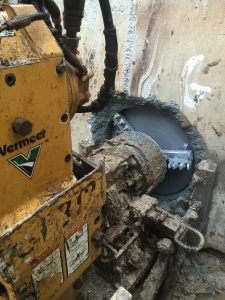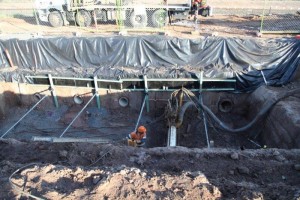When it comes to microtunnelling installations, there is a variety of methods and systems available, so it is important to choose the right technique to suit your individual site and project specifications. It’s particularly crucial for contractors to work with a machine that can work through a wide range of ground conditions, with a variety of pipes and configurations.
However, most systems available to contractors lack the versatility to work through a wide range of ground conditions, or to offer a variety of pipes and configurations.
The lack of versatility in many microtunnelling systems can cause problems on the jobsite when conditions are different than expected, as can often be the case. With a rigid system, adaptations are hard to make, and this can cost clients time and money.
Frustrated with the lack of versatility offered by microtunnelling equipment available on the market, in 2002 Australian microtunnelling expert Stuart Harrison set about creating his own guided boring system. The result was what is now known as the Vermeer AXIS guided boring system. It is a pit-launched mictrotunnelling method, uniquely designed to provide contractors with a versatile system that combined high efficiency, productivity and pinpoint precision. This allows contractors to complete microtunnelling jobs with minimal risk, while saving time and money.
We sat down to talk with Mr Harrison to talk about versatile microtunnelling with minimal risk.
Adaptable pilot lines

When utilising the displacement method, contractors need to be weary of the effect of the displacement of the ground of the surrounding assets. The extraction method does not have this drawback.
The Vermeer AXIS machine is designed to cut and extract the ground as it moves, and in doing so, has little to no influence on the ground directly surrounding the installation. By extracting the earth, rather than displacing it, microtunnellers can visually inspect the condition of the earth that is being excavated at the face.
Mr Harrison said knowing the existing ground conditions, and being able to adapt to them, is the key to getting a microtunnelling job completed with minimal risk.
“Traditional slurry microtunnelling techniques rely on the jacking of a product pipe to propel the microtunnel head,” Mr Harrison said.
“But when the ground substantially changes mid-installation – to the point where the contractor can no longer proceed with the line – inevitability there will be a need to dig up the head, which is a far from ideal outcome.”
However, new technology such as the Vermeer AXIS guided boring system provides a solution. It allows contractors to complete a 345mm pilot line before upsizing and jacking.
“The Vermeer AXIS guided boring system gives contractors the ability to retract, access and change the machine head part way through drilling the pilot line. Contractors are able to configure the cutting tool to test for changing conditions before committing to jacking the final line,” Mr Harrison said.
Changing ground conditions
When it comes to planning for a microtunnelling installation, it’s important to remember that the information provided by geotech surveys does not always give the complete picture of the ground conditions, or they may be incorrect.
This is why the information a pilot line provides to contractors is so crucial. Beginning a microtunnelling project where the exact changing ground conditions are unknown can create numerous problems for contractors, that cost time and money. And the reality is, most cannot be easily adjusted to deal with changing conditions.
According to Mr Harrison, most microtunnelling machines can only move in a forward direction. This means once drilling has commenced, if the chosen cutter is not suitable to the ground conditions encountered, the best option is to dig a shaft down towards the drill before changing the head.
“The big advantage of the Vermeer AXIS guided boring system is its ability to come back, retract and change bits. There’s no impact to the ground, and you’re still able to create a successful outcome for all parties,” Mr Harrison said.
The machine has a variety of parts and cutter face options that can be swapped to boost drilling performance in most ground conditions including rock, shale, clay and sand, mud and silt.
“Traditional methods pipe jack from the outset, therefore any variations in ground conditions, if not allowed for, can cause deviation or the termination of a microtunnel line,” Mr Harrison said.
“Vermeer AXIS is a good performer across all ground and it can be setup to suit whatever the ground condition is. This gives contractors the ability to determine a better setup for the machine to ensure that the installation’s done effectively and efficiently.”
A variety of diameters

Mr Harrison said the Vermeer AXIS guided boring system only requires one drill head to complete a pilot line. Once the pilot line is completed, it’s just a matter of changing the size of the reaming tool to achieve a range of diameters, depending on the installation in question. Importantly, the cost of these reaming tools is relatively inexpensive, enabling cost-efficient installations.
“Vermeer AXIS is regularly used to install pipe in the 300-600mm range, and to date, the largest ever installation was of a 900mm pipeline,” Mr Harrison said.
This versatility is due to the fact that the Vermeer AXIS system can install pipe via either the pilot and pull back method, or the jack and ream method.
With the jack ream method, when the drill head reaches the exit pit, it is replaced with a reaming tool which can be attached to the product pipe when pulling back, or in the jack back method, the pipe would effectively push the pilot line back out during the reaming process.
Mr Harrison said the ability to use the jack ream method allows the contractor to be flexible when choosing the installation method best suited to the site. It is also a lower risk installation method, as it uses the pilot line created by the drill head between the launch and exit pits to pull or jack back the pipes, rather than jacking it into unconfirmed ground conditions at an elevated risk.
Wide range of pipes
Traditional microtunnelling methods typically rely on the use of jacking pipe, as it transmits the thrust from the jacking station to the drill head to progress the line. However, with the Vermeer AXIS guided boring system, the use of its unique pilot line method and vacuum extraction can create the unique situation where in self supporting ground, the force on a pipe would only be the weight of the pipe itself. In this case, the pipe selection only truly relates to the ground conditions, as the method doesn’t require the use of a highly structural pipe.
“Vermeer AXIS is able to install a wide range of pipe types, including both rigidly constructed, as well as fusible and restrained joint product pipe,” said Mr Harrison.
“The system is compatible with both high and low strength products including PVC, PVE, concrete, clay, steel encased, ductile iron and HDPE.”
This versatility gives clients more product pipe options based on factors such as existing ground conditions, costs, traditional preference, and matching with existing infrastructure.
Low cost production

However, another benefit of the Vermeer AXIS guided boring system is the fact that it was also designed to keep the cost of microtunnelling down and include benefits to make it more competitive with open-cut and other trenchless installations.
One of the benefits of the system is that it does not require structural pits where the ground conditions are relatively stable. It’s the combination of a carefully designed drill head with a vacuum extraction method that allows the Vermeer AXIS to effectively core it’s pilot hole through the ground, leaving a dry and stable pilot hole. By leaving the pilot hole dry, we do not see the typical situation of ground swell in certain clay style conditions. Compared to other microtunnelling systems, the Vermeer AXIS guided boring system requires a low amount of thrust and pullback force to create a bore in these relatively stable conditions.
“This means it doesn’t need a structural backstop or shaft constructed in the launch pit, reducing the costs and saving time as machine preparation is minimal,” Mr Harrison said.
It also offers precise on-grade drilling to within +/- 5mm. The system utilises a CCTV camera that is built into the drill head to allow the contractor to constantly monitor the process of the drilling. Using a laser as a guide, the operator can make adjustments to the steering of the drill head to ensure line and grade is maintained.
“The Vermeer AXIS guided boring system has shown to be able to complete 300 meters on-line, on-grade within a week,” Mr Harrison said.
Furthermore, compared to open-cut methods the Vermeer AXIS guided boring systems has minimal restoration costs. All that is required is the surface excavation of two pits that can serve as the manhole locations. This saves additional excavation time and resources, and reduces surface reconstruction costs. It also reduces the jobsite footprint, creating a truly keyhole pipeline installation.
This is helped by the flexible nature of the system design. The Vermeer AXIS guided boring system can be configured in a number of ways depending on jobsite footprint and transport considerations. It has a number of truck and trailer setup options to accommodate client preference and limit its impact on the surrounding area such as utilising only one lane of a street to minimise traffic disturbance.
Risk minimisation
According to Mr Harrison, microtunnelling with a versatile machine essentially comes down to one simple concept: risk minimisation.
“When it’s all said and done, we are all looking to reduce the risk on our trenchless projects,” Mr Harrison said.
“And that’s what we’ve been able to achieve with the Vermeer AXIS guided boring system.”

